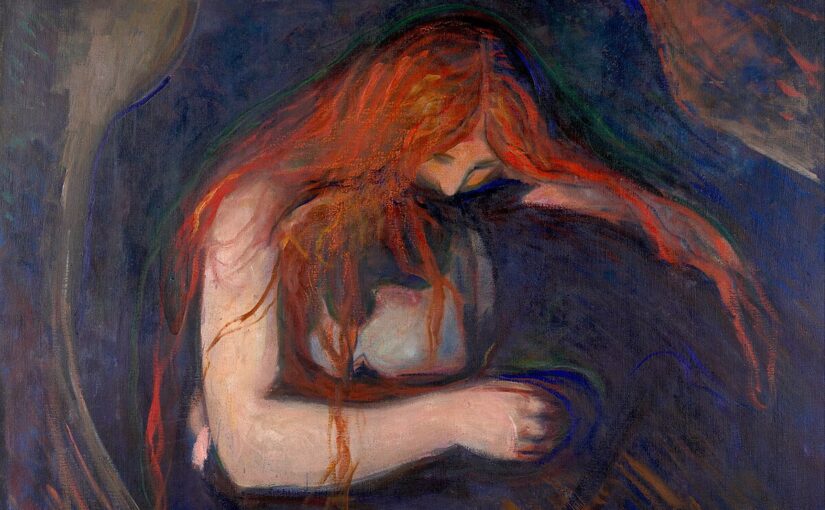For this blog post, I will consider Dracula through the lens of Edvard Munch’s painting Love and Pain, also known as The Vampire. This painting, which appears on the cover of my copy of Dracula, was finished in its first iteration in 1893, while Dracula wasn’t published in 1897. It displays a woman and a man locked in an embrace, with the man clutched in the woman’s arms. Her bright red hair enshrouds the man, wavy strands running down his back and over his face. The man’s head is buried in the woman’s breast, while the woman’s mouth rests on the back of his neck. This is where the alternate title of Vampire finds its foundation. Though Munch maintained that the painting simply depicted a woman kissing her lover’s neck in a sign of comfort, the contemporary public interpreted it instead as a vampiric bite. Many were appalled by the composition – a man forced into submission by a powerful, seductive female vampire.
As a result, this painting has become an infamous representation of the Femme Fatale, in particular the archetype of the Vampiric Woman, which is depicted in much Symbolist art of the fin de siècle. This character evokes the Victorians’ fear of the growing power of woman, most prominently in connection to her sexuality. A visual analysis of the painting in this light offers a starkly different reading: The red hair appears as blood, running in rivulets over the vampire’s victim. While the man’s face is bluish gray, as if drained of life, the woman’s face is flushed with a reddish hue, an effect of the blood she is taking in. A dark blob surrounds the figures, suggesting the woman is emanating a dark power with which she holds the man in her thrall. Lastly, the woman’s sexuality is indicated by her lack of visible clothing. Although her body is obscured by the man’s (clearly clothed) form, we see her bare arm and shoulder with no sign of a sleeve or strap.
Even if Munch did not intend the painting to be seen in this way, the cultural associations with Love and Pain give it an entirely new life. In fact, it is that very ambiguity between lover and vampire, kiss and bite, which reveals how the vampiric bite is inherently erotic. This what makes the vampire (the female vampire in particular) such a threat: that she would use her sexuality to overpower man and make him submissive in a fatal inversion of gendered power dynamics is what terrified the Victorians.
Reading Dracula through the lens of this painting, the scene when Jonathan encounters the vampire brides takes on a new meaning. Though none of the three women have red hair like the painting’s figure, the color red features heavily in their appearances. Stoker describes their “great dark, piercing eyes, that seemed to be almost red” (44). Additionally, the women have “scarlet lips” and a “red tongue” (Stoker 45). The repetition of redness emphasizes the unspoken presence of the part of the body most significant in this scene: blood.
Furthermore, Stoker’s writing engages with the duality of kiss/bite in an almost playful manner. In the seductive thrall of the vampires, Jonathan thinks, “I felt in my heart a wicked, burning desire that they would kiss me with those red lips” (Stoker 45). The explicit mention of “desire” and “kiss” emphasize the eroticism of this interaction. Though perhaps Jonathan did not know of the true intentions of the women, they themselves tease this ambiguity as one declares, “He is young and strong; there are kisses for us all” (Stoker 45). The vampire women deliberately frame their intended bite as a “kiss,” admitting the erotic nature. Lastly, this is reiterated by Dracula himself when he sweeps in to disrupt the bite: He promises, “when I am done with him you shall kiss him at your will” (Stoker 45). The repetition of “kiss” throughout this scene, along with the absence of any mention of “bite,” reinforces the sexual undertones (or rather, overtones) present in the scene.
The distinct moment in which this dichotomy is most prevalent comes at the bottom of page 45 and onto page 46 (“Lower and lower went her head…just touching and pausing there.”), when the blonde vampire prepares to bite Jonathan. Stoker describes in excruciating detail the process of lowering her lips to his neck, fastening the mouth to the skin, tongue moving, teeth poking, and so on. The passage finishes with, “I closed my eyes in a languorous ecstasy and waited – waited with beating heart” (Stoker 46). While highly erotic, this passage emphatically toes the line between bite and kiss. Stoker accentuates Jonathan’s titillating anticipation, as even he is unsure what will happen next. His closed eyes and beating heart create the sensation of edging toward a climax…which never comes.

This is a really cool analysis!! Also, what a pretty painting! It’s very interesting that people interpreted it as a vampire and also saw the woman as a “threat.” I wonder who from the novel would fit into these characters and if there are any overlap? For example, could Dracula be both the lady and the man in this painting? If we read the whole novel through the lens of this painting maybe it is possible that the fear of Mina turning into a vampire was because they did not want her to “overpower” the men like many people interpreted the painting.